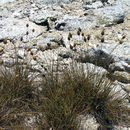Comments
provided by eFloras
Carex breweri occurs in the Sierra Nevada and Cascade Mountains north to Mt. Hood.
A. Cronquist (1969) considered Carex breweri and C. engelmannii conspecific; he distinguished them at the varietal level by a difference in pistillate scale characters. The correlated differences in perigynium shape and veins, the dimensions of most structures, and the foliar anatomy support their retention as distinct species.
- license
- cc-by-nc-sa-3.0
- copyright
- Missouri Botanical Garden, 4344 Shaw Boulevard, St. Louis, MO, 63110 USA
Description
provided by eFloras
Rhizomes 2–3 mm thick. Culms 15–22(–30) cm, 2.5–3 mm thick at base. Leaves: sheaths 2–3 cm, fronts often mottled dark brown; blades flattened laterally, with 5–8 conspicuous air cavities, median groove inconspicuous, elliptic in cross section, 10–20(–25) cm × 0.6–1.2 mm. Inflorescences 1.4–2.5 cm × 7–12 mm, staminate portion 2–10 mm. Pistillate scales white medially, 3–5-veined, shorter and narrower than perigynia, leathery, apex acute to acuminate; proximal scales sometimes awned to 4 mm. Anthers 2–3 mm. Perigynia angles veined, shortly 3–10-veined on faces, sessile, broadly elliptic, 5–7 × 3–4.8 mm, base rounded, apex rounded; beak entire; rachilla longer than fruit. Stigmas 1–2 mm. Achenes stalked to 0.15 mm.
- license
- cc-by-nc-sa-3.0
- copyright
- Missouri Botanical Garden, 4344 Shaw Boulevard, St. Louis, MO, 63110 USA
Habitat & Distribution
provided by eFloras
Fruiting Aug–Sep. Dry rocky or gravel slopes; above 2500 m in Calif., above 2000 m in Oreg.; Calif., Nev., Oreg., Wash.
- license
- cc-by-nc-sa-3.0
- copyright
- Missouri Botanical Garden, 4344 Shaw Boulevard, St. Louis, MO, 63110 USA
Comprehensive Description
provided by North American Flora
Carex breweri Boott, 111. Carex 142. pi. 455. 1867
Rootstock stoloniferous, slender but tough, brown, scaly, the culms numerous, 1-2.5 dm. high, smooth on the angles, strict and stiff, obtusely triangular, more or less exceeding the leaves, brown at base and clothed with the dried-up leaves of the previous year, the lower bladeless; leaves with well-developed blades 3-10 to a fertile culm, clustered towards the base, the blades involute-filiform, erect, stiff, 5-10 cm. long, 1 mm. wide, roughened towards the attenuate apex, the sheaths loose, strongly striate dorsally, hyaline ventrally, truncate at mouth, the ligule very short; spike solitary, androgynous, bractless, ovoid or oblong-ovoid, 1-2 cm. long, 6-10 mm. wide, densely flowered, the upper third or more staminate, conspicuous, the perigynia ascending or at length spreading in many rows; staminate scales ovateoblong, short-acuminate, reddish-brown with hyaline margins; pistillate scales ovate, broader, 3-nerved and sometimes striate, tapering-acute or short-acuminate, narrower and shorter than the mature perigynia; perigynia broadly ovoid, 5-6.5 mm. long, 3.5 mm. wide, strongly inflated, brownish-yellow, smooth, shining, very membranaceous, nerveless or nearly so, slightly stipitate, rounded at base, abruptly minutely beaked, the beak 0.5-1 mm. long, smooth, white-hyaline, obliquely cut, at length bidentulate; achenes oblong-obovoid, triangular with concave sides, apiculate, brownish, stipitate, 2 mm. long, 1 mm. wide, much smaller than perigynia and very loosely enveloped; style slender, jointed with achene, not enlarged at base, deciduous; stigmas three, slender, reddish-brown; rachilla slender, exceeding achene; anthers 1.75 mm. long, sharp-tipped.
Type locality: Mt. Shasta, California (Brewer 1422).
Distribution: Open sunny slopes and summits, high alpine peaks, Washington, Oregon, and southward in California on the higher summits of the Sierra Nevada to Mt. Whitney. (Specimens examined from Washington, Oregon, California.)
- bibliographic citation
- Kenneth Kent Mackenzie. 1931. (POALES); CYPERACEAE; CYPEREAE (pars). North American flora. vol 18(1). New York Botanical Garden, New York, NY
Carex breweri: Brief Summary
provided by wikipedia EN
Carex breweri, known as Brewer's sedge, is a species of sedge that grows on dry rocky or gravel slopes in the Sierra Nevada and Cascade Mountains of the western United States, as far north as Mount Hood. It is classified in Carex sect. Inflatae, alongside Carex engelmannii and Carex subnigricans.
- license
- cc-by-sa-3.0
- copyright
- Wikipedia authors and editors

